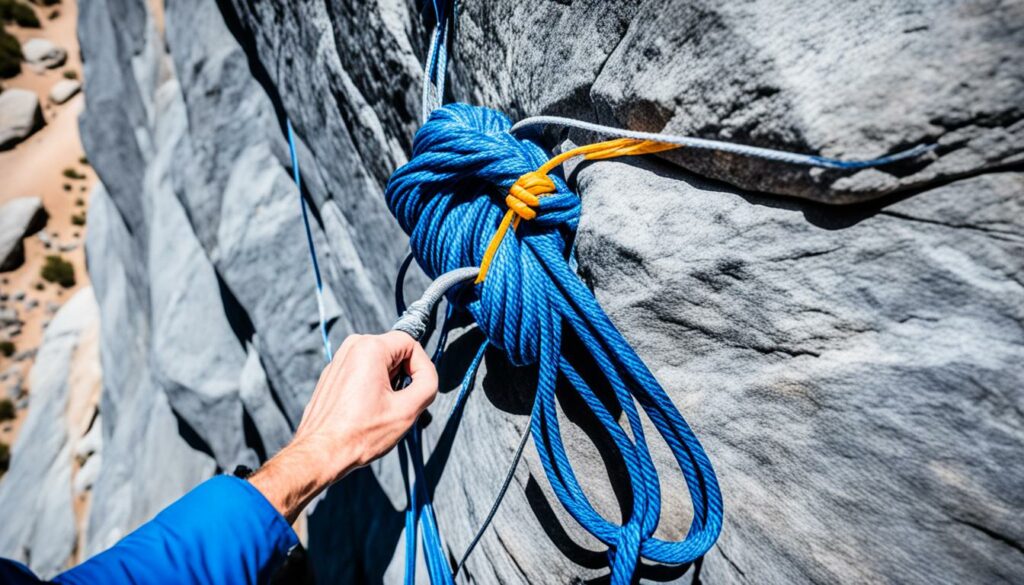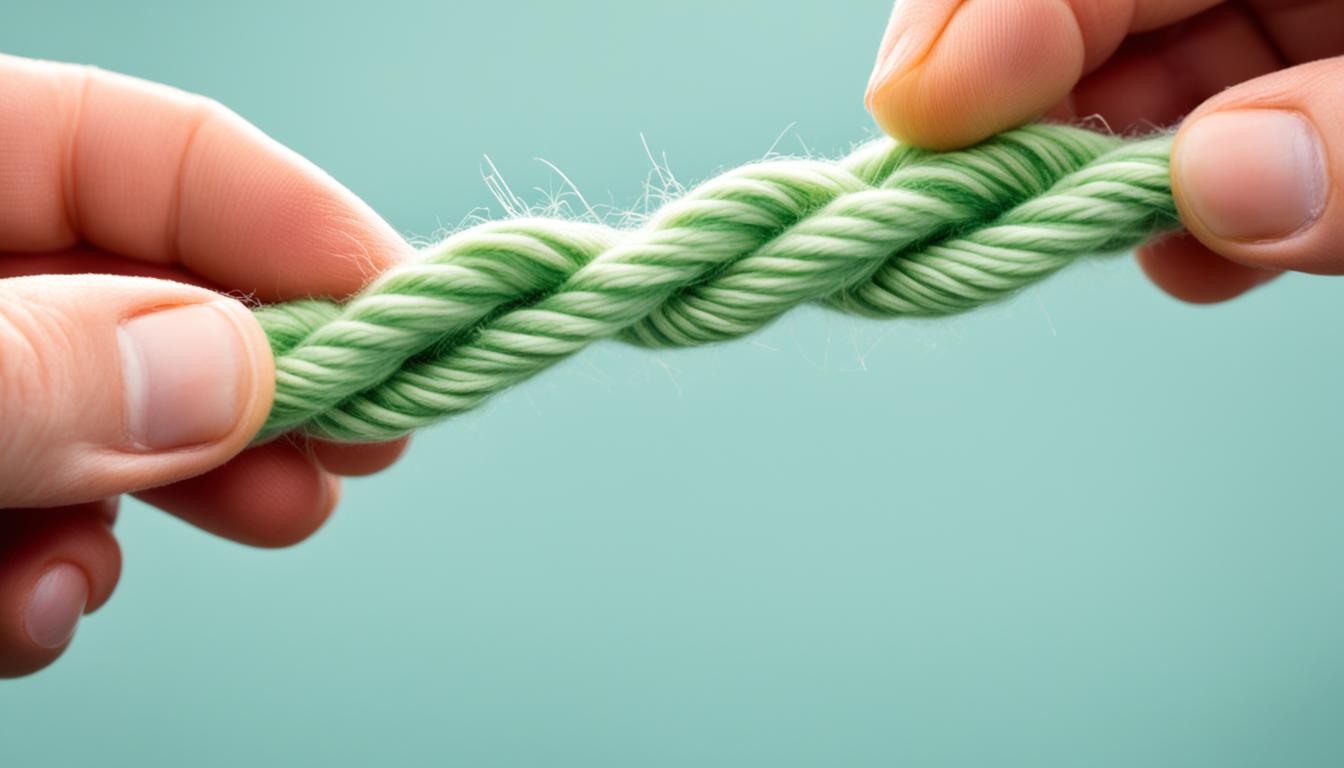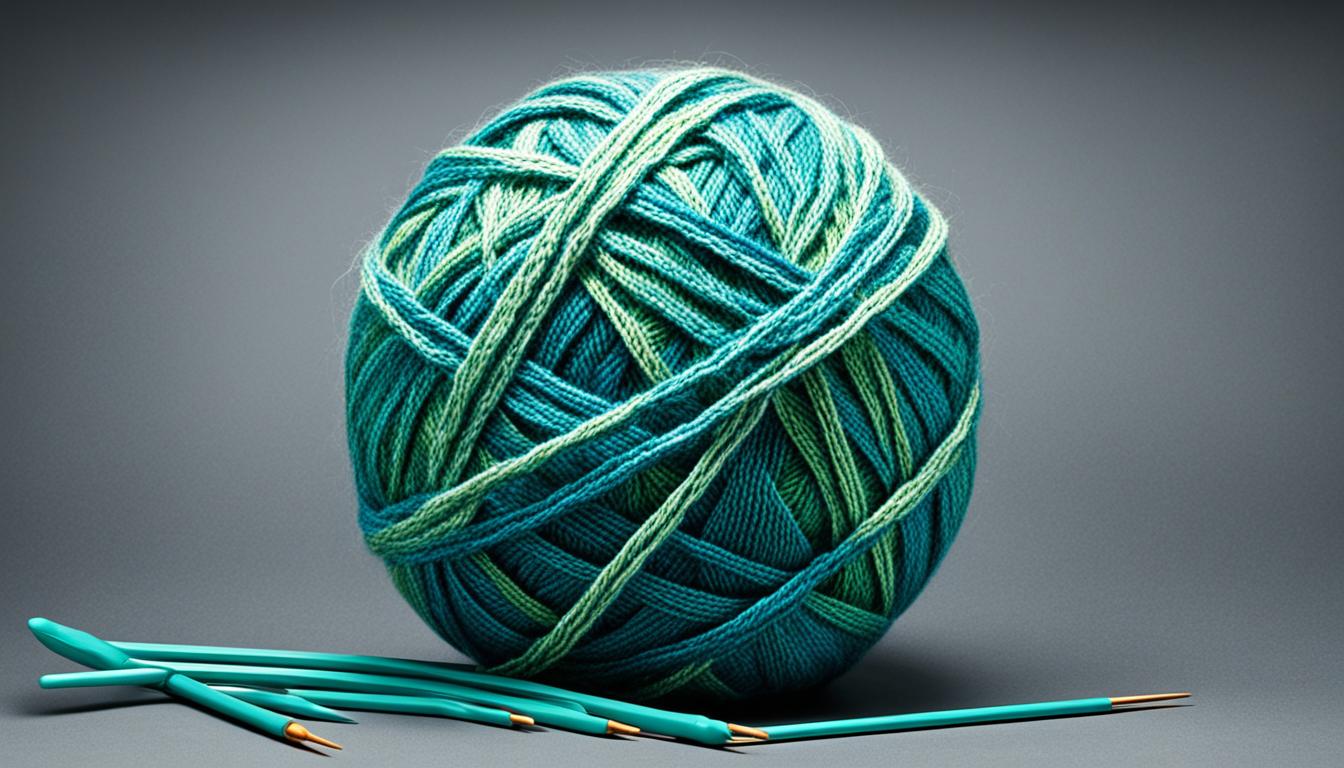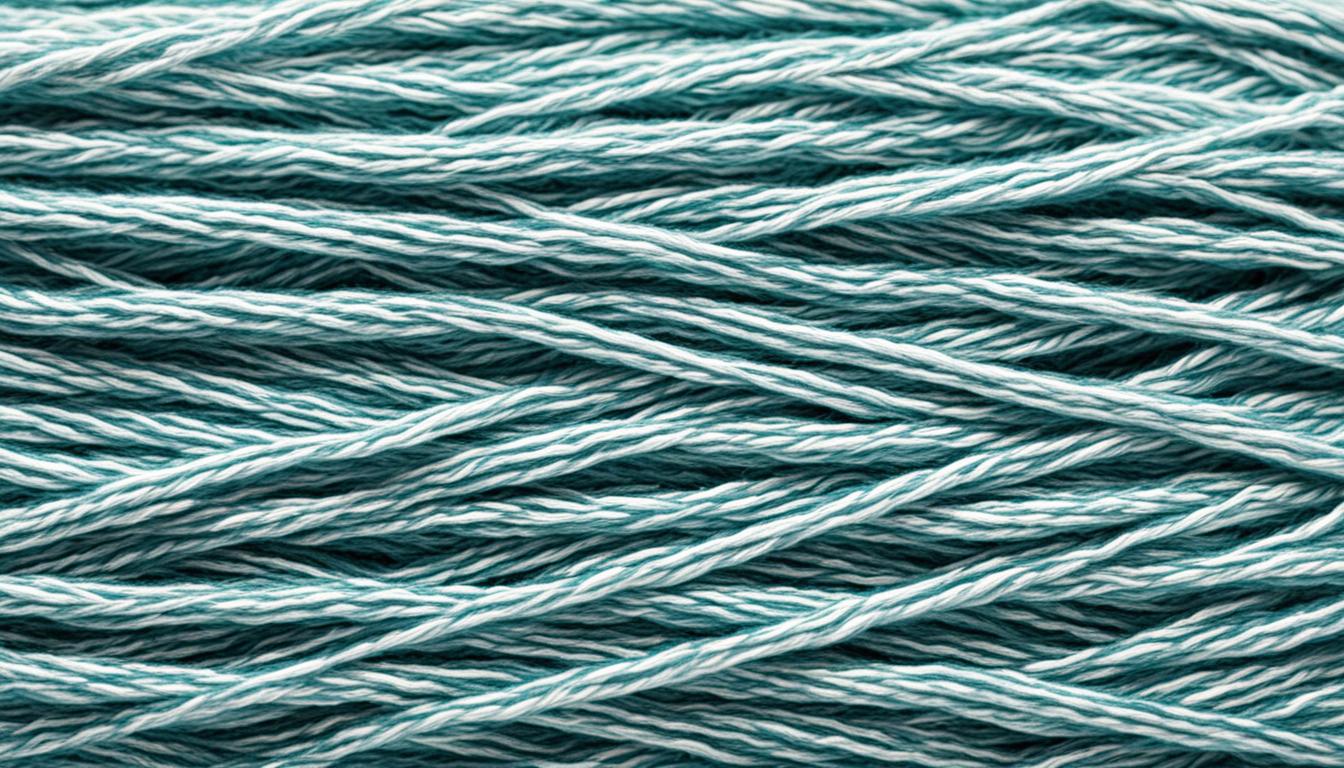Have you ever stopped to ponder what gives your clothes, toothbrush, and even ropes their strength and durability? The secret lies in an incredible synthetic material called nylon yarn. But what exactly is nylon yarn and how is it manufactured? And why is it such a popular choice for a wide range of everyday products? Let’s delve into the mysteries of nylon yarn and explore its properties, advantages, and applications.
Key Takeaways:
- Nylon yarn is a synthetic material known for its strength and durability.
- It was the first fabric made entirely in a laboratory.
- Nylon yarn is derived from crude oil through a chemical process called condensation polymerization.
- It is widely used in various everyday items, including clothing, toothbrushes, and ropes.
- Despite its versatility, nylon yarn has a significant environmental impact.
The History of Nylon
Nylon, an iconic synthetic fiber, has a rich history that spans back to its invention in the 1930s. Let’s explore how this remarkable material came to be and its significant impact on various industries.
Invention of Nylon
In the 1930s, a team of brilliant chemists at DuPont laboratories embarked on a mission to create a durable synthetic fiber. Their goal was to develop a material that could replace silk in parachutes, addressing the need for a strong and reliable alternative during World War II.
After years of intensive research and experimentation, the team succeeded in creating the world’s first fully synthetic fabric. This breakthrough invention was named nylon, derived from the combination of “New York” and “London” – the two cities where the research was conducted.
Nylon in World War II
During World War II, nylon revolutionized the production of parachutes, offering soldiers a lightweight and resilient alternative to silk. Its superior strength and performance helped ensure the safety and efficiency of military operations.
Beyond parachutes, nylon also found its way into various military applications, including tents, ropes, and flak jackets. Its exceptional durability and versatility made it an invaluable material for the armed forces.
Nylon in the Fashion Industry
After the war, nylon became widely available to the public, quickly gaining popularity in the fashion industry. This innovative fabric rapidly replaced silk in the production of stockings, offering women a more affordable and accessible option.
The introduction of nylon stockings created a sensation, with long queues forming outside stores as women clamored to purchase this new fashion essential. The durability and sheen of nylon made it a desirable choice, surpassing the delicate nature of silk stockings.
Over time, the fashion industry embraced nylon, incorporating it into various garments. Nylon proved to be a versatile fabric, ideal for outerwear, swimwear, lingerie, and more. Its lightweight nature and quick-drying properties made it perfect for beachwear and sportswear.
What is Nylon and How is It Made?
Nylon is a synthetic polymer made from petrochemicals derived from crude oil. It is a polyamide that is formed through a process called polymerization. The main raw materials for nylon production are adipic acid and hexamethylene diamine. These materials are combined under controlled conditions to form long polyamide chains, which create the nylon polymer. The production process involves specific methods and technologies to ensure the quality of the nylon fabric.
Nylon Chemical Composition
The chemical composition of nylon includes adipic acid and hexamethylene diamine. Adipic acid is a dicarboxylic acid, while hexamethylene diamine is a diamine. When combined, these two chemicals react with each other in a condensation polymerization reaction to form the polyamide chains that make up nylon.
Nylon Polymerization
Polymerization is the process by which the monomers, adipic acid, and hexamethylene diamine, react to form the nylon polymer. During polymerization, the molecules of the monomers join together, bonding through the amide functional groups in a repetitive pattern, creating long chains of nylon. This polymerization process can be controlled to produce different types of nylon with varying properties.
Nylon Production Process
The production process of nylon involves several steps. First, the raw materials, adipic acid, and hexamethylene diamine, are synthesized from crude oil. Then, these materials undergo purification to remove impurities. Next, the purified materials are mixed together in the right proportions and introduced into a reactor. Under controlled conditions of temperature and pressure, the monomers react and polymerize to form the nylon. The resulting nylon is then cooled, solidified, and processed into various forms, such as fibers or plastic pellets, depending on its intended use.
Raw Materials for Nylon Production
The main raw materials used in the production of nylon are adipic acid and hexamethylene diamine. Adipic acid is derived from cyclohexane, which is obtained from crude oil. Hexamethylene diamine is synthesized from adiponitrile, which is also derived from crude oil. These raw materials are carefully selected and processed to ensure the high quality and performance of the final nylon product.
| Raw Material | Chemical Formula | Source |
|---|---|---|
| Adipic Acid | C6H10O4 | Cyclohexane derived from crude oil |
| Hexamethylene Diamine | C6H16N2 | Adiponitrile derived from crude oil |

Nylon vs Other Fibers
Nylon, a synthetic material, possesses distinct properties that set it apart from other fibers. When compared to polyester, nylon exhibits superior strength and resilience, making it more durable in various applications (nylon vs polyester). However, nylon is less moisture-wicking and has lower breathability than polyester.
Unlike cotton, nylon fabric offers enhanced durability and abrasion resistance, making it a preferred choice for items that require long-lasting strength (nylon vs cotton). Nylon’s exceptional durability ensures that it maintains its shape and withstands repeated use and frequent washing.
Nylon also competes favorably with silk due to its strength and versatility. While silk has long been cherished for its smoothness and luxurious sheen, nylon can mimic these qualities while being more affordable and easier to care for (nylon vs silk). Nylon fabric provides a cost-effective alternative without compromising on elegance or style.
Nylon holds several properties that make it suitable for a diverse range of applications. Below is a comparison chart highlighting the properties and characteristics of nylon fabric in contrast to other fibers:
| Nylon | Polyester | Cotton | Silk | |
|---|---|---|---|---|
| Strength | High | Medium | Low | Medium |
| Durability | High | Medium | Low | Medium |
| Moisture-Wicking | Low | High | High | Medium |
| Breathability | Low | High | High | Medium |
| Abrasion Resistance | High | Medium | Low | Medium |

The Uses of Nylon Yarn
Nylon yarn is an incredibly versatile material with a wide range of applications in different industries. Let’s explore some of the key uses of nylon yarn:
Nylon in Clothing
Nylon yarn is commonly used in the fashion industry for various types of clothing. Its strength and durability make it ideal for garments that require resilience and a long lifespan. Nylon is frequently utilized in the production of outerwear, swimwear, lingerie, and activewear. Its flexibility allows for comfortable movement, while its moisture-wicking properties help keep the wearer dry and comfortable.
Nylon in Industrial Applications
Due to its exceptional strength, nylon yarn finds extensive use in industrial applications. It is frequently employed in the manufacturing of ropes, cables, and harnesses due to its high tensile strength and resistance to abrasion. Nylon’s toughness and durability make it suitable for industrial settings where reliability and longevity are essential. Additionally, nylon is utilized in the production of automotive components that require strength and stability.
Nylon in Consumer Goods
Aside from clothing and industrial applications, nylon yarn is also prevalent in the production of various consumer goods. In toothbrushes, nylon bristles are commonly used for their flexibility, durability, and ability to effectively clean teeth. Nylon’s resistance to moisture makes it an excellent choice for food packaging as well, ensuring that the contents remain fresh and protected.
“Nylon yarn is a versatile material that finds applications in a wide range of industries, including fashion, manufacturing, and consumer goods.”
Applications of Nylon Yarn
| Industry | Applications |
|---|---|
| Fashion | Outerwear, swimwear, lingerie, activewear |
| Industrial | Ropes, cables, harnesses, automotive components |
| Consumer Goods | Toothbrushes, food packaging |
As demonstrated, nylon yarn has diverse applications in clothing, industrial settings, and consumer goods. Its strength, durability, and versatility allow for creative and practical uses across various industries.

Nylon Yarn Production and Specifications
Producing nylon yarn involves a complex manufacturing process that transforms raw materials into versatile and durable fibers. The process begins with the melting of raw materials, typically adipic acid and hexamethylene diamine, which are extruded through a spinneret to create individual yarn fibers. These fibers can then be woven or knitted into fabric, suitable for various applications.
Nylon yarn comes in different specifications, allowing for customization based on specific needs. The specifications include:
- Denier: Denier refers to the weight of the nylon yarn. It measures the linear mass density of the yarn and determines its thickness and strength. Higher denier yarns are thicker and more durable, while lower denier yarns are finer.
- Filament Count: Filament count refers to the number of individual filaments in the nylon yarn. A higher filament count results in a denser and stronger yarn, while a lower filament count creates a more lightweight and delicate yarn.
- Twist: Twist refers to the degree of twist in the nylon yarn. The level of twist affects the yarn’s appearance, strength, and texture. Low twist yarns have a smoother and shinier appearance, while high twist yarns exhibit more strength and durability.
Various manufacturers and suppliers around the world are dedicated to producing and providing high-quality nylon yarn. These manufacturers ensure consistent production standards and deliver reliable products to meet the growing demand for nylon yarn in different industries.

“Manufacturing nylon yarn involves a meticulous process that transforms raw materials into versatile fibers. The specifications of the nylon yarn, including denier, filament count, and twist, determine its use and durability. With various manufacturers and suppliers available, the demand for nylon yarn can be met effectively.”
The Environmental Impact of Nylon
Nylon, a popular synthetic material, has become widely used in various industries due to its strength and durability. However, it’s essential to recognize the significant environmental impact associated with nylon production and disposal.
Nylon is derived from crude oil, contributing to greenhouse gas emissions and the depletion of fossil fuels. The extraction and processing of crude oil release harmful pollutants into the atmosphere, contributing to climate change. Additionally, the production process for nylon requires a substantial amount of energy and water, further exacerbating its environmental footprint.
One of the most significant environmental concerns with nylon is its non-biodegradability. Nylon can take hundreds of years to break down in landfills, adding to the growing waste crisis. This raises concerns about the accumulation of nylon waste in the environment and its long-term impact on ecosystems.

The production of nylon has a significant environmental impact, including greenhouse gas emissions, depletion of fossil fuels, and non-biodegradability.
However, there are ongoing efforts to make nylon more sustainable and reduce its environmental impact. One such approach is the use of recycled nylon. Recycled nylon, also known as ECONYL, is produced from discarded fishing nets, industrial waste, and post-consumer nylon products. By diverting waste from landfills and repurposing it into new nylon products, the recycling process helps reduce the demand for virgin resources and minimize environmental harm.
Another avenue being explored is the development of bio-based nylon. Bio-based nylon is derived from renewable resources such as plant-based materials or biomass. By utilizing renewable feedstocks, bio-based nylon aims to reduce reliance on fossil fuels and lower carbon emissions associated with its production.
By embracing these sustainable alternatives, the fashion industry and other sectors can make strides towards reducing the environmental impact of nylon. Sustainable fashion brands are increasingly adopting recycled and bio-based nylon, offering consumers more eco-friendly choices without compromising on quality or performance.
Listed below are the key points about the environmental impact of nylon:
- Nylon is derived from crude oil, contributing to greenhouse gas emissions and the depletion of fossil fuels.
- The production process consumes a significant amount of energy and water.
- Nylon is non-biodegradable, taking hundreds of years to break down in landfills.
- Efforts are being made to make nylon more sustainable through the use of recycled nylon and bio-based nylon derived from renewable sources.
It is crucial for manufacturers, consumers, and policymakers to prioritize the sustainability of nylon and work towards reducing its environmental impact. By embracing recycled and bio-based alternatives, we can move towards a more sustainable and responsible future.
Innovations and Alternatives to Nylon Yarn
As we strive for a more sustainable future, there are ongoing innovations and alternatives to traditional nylon yarn that aim to reduce its environmental impact. These advancements offer eco-friendly options and lower-impact materials for conscious consumers and industries alike.
Recycled Nylon
One notable sustainable alternative to traditional nylon is recycled nylon. Brands like ECONYL are transforming discarded fishing nets, industrial plastic, and waste fabrics into high-quality nylon yarn. By repurposing these materials, we can reduce waste and minimize the reliance on newly produced nylon, making a positive impact on the environment.
Bio-based Nylon
Another promising development in the world of nylon yarn is bio-based nylon. This type of nylon is derived from renewable sources, such as plant-based materials or bio-synthetics. By using renewable resources to create nylon, we can significantly decrease its carbon footprint and lessen the dependence on fossil fuels.
The Importance of Choosing Sustainable Options
While innovations like recycled nylon and bio-based nylon offer sustainable alternatives, it is also essential to consider the lifecycle of a garment when choosing yarn materials. Opting for eco-friendly yarn options like organic cotton, hemp, or bamboo can further minimize the environmental footprint of the finished product.
“By choosing sustainable nylon alternatives and eco-friendly yarn options, we can contribute to a more circular and responsible textile industry.”
By embracing sustainable practices and materials throughout the supply chain, we can make significant strides in reducing the environmental impact of the fashion and textile industry. This approach not only benefits the planet but also provides consumers with ethical and conscious choices when it comes to their wardrobe.

Conclusion
In summary, nylon yarn is a synthetic material made from petrochemicals that offers remarkable strength, durability, and versatility. Its wide range of applications in the fashion industry, industrial settings, and consumer goods make it a popular choice. However, it is crucial to acknowledge the significant environmental impact of nylon and its non-biodegradable nature.
We are committed to promoting sustainability in the textile industry. Efforts are underway to make nylon production and usage more sustainable through the development of recycled and bio-based alternatives. Recycled nylon, such as ECONYL, and bio-based nylon derived from renewable sources show promising potential in reducing the environmental footprint of nylon yarn.
As conscientious consumers, it is essential to consider the environmental impact of the materials we choose. While nylon yarn offers exceptional properties, we should also explore lower-impact alternatives whenever possible. By making mindful choices, we can contribute to a more sustainable future and minimize the impact of nylon yarn on the environment.










